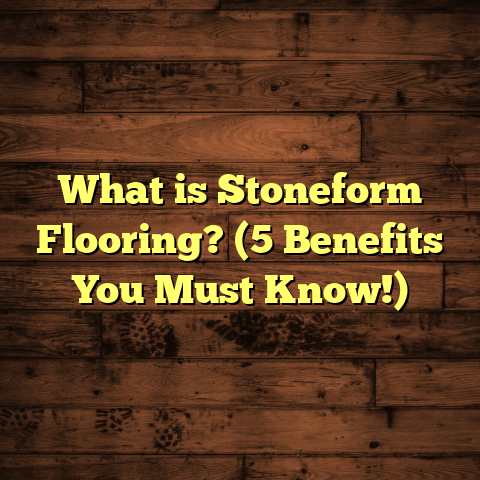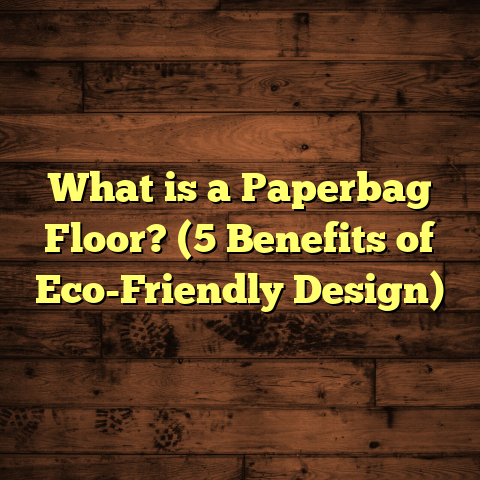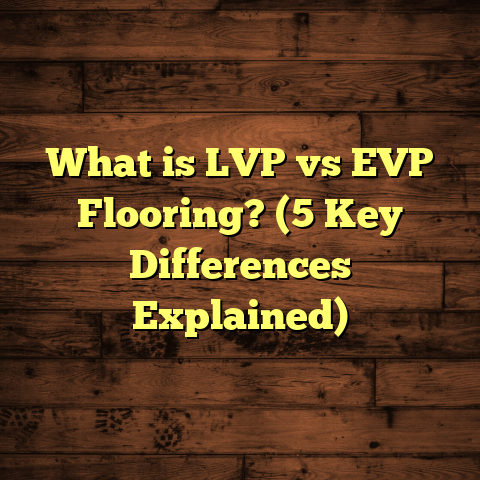What is a Floor Cloth? (5 Benefits for Stylish Interiors)
I once found myself in a quirky antique shop, poking around for unique decor ideas. Amidst aged furniture and vintage trinkets, a rolled-up canvas caught my eye. It wasn’t just any fabric—it was an old-fashioned floor cloth. At first, I thought it was some kind of oversized painting or rug. But as I unrolled it, the detailed painted patterns and thick texture made me realize this was something special. What surprised me the most was how durable and beautiful this piece was, even after decades.
That moment changed how I think about flooring options. Floor cloths are more than relics of the past—they offer a unique blend of style, durability, and practicality that modern flooring often misses. If you’ve never heard of floor cloths or dismissed them as outdated, this article will open your eyes to their potential as a stylish interior choice.
What Is a Floor Cloth?
At its simplest, a floor cloth is a heavy canvas or fabric that’s been painted and sealed to create a robust covering for floors. Think of it as a hybrid between a rug and painted flooring. It’s designed to be walked on, withstand wear and tear, and add decorative flair to any room.
Floor cloths date back to the 18th century when they were popular as affordable alternatives to pricey carpets. People painted patterns or scenes onto sturdy canvas and sealed them with protective coatings like linseed oil or varnish. This made them water-resistant and durable enough to handle foot traffic.
Today, floor cloths are typically made from cotton duck canvas—a heavy-duty fabric weighing around 10 oz per square yard or more. The canvas is stretched flat and then painted with layers of acrylic or oil-based paints. After the design is complete, several coats of polyurethane or marine varnish are applied to protect the surface.
How Are Floor Cloths Different from Rugs or Painted Floors?
Unlike rugs, floor cloths are not woven or tufted but painted on solid fabric. Unlike traditional painted floors directly on wood or concrete, floor cloths can be moved, replaced, or layered over existing flooring without damaging the substrate.
This makes them a flexible option for renters or those wanting a temporary yet attractive solution.
Common Uses for Floor Cloths
- Covering worn or damaged floors without removing them.
- Adding color and pattern to plain or boring floors.
- Protecting floors in high-traffic areas like kitchens, hallways, and entryways.
- Creating focal points under dining tables or seating areas.
- Using as wall hangings or decorative table covers (a fun bonus!).
In my own experience, floor cloths have been incredibly useful when clients need an affordable facelift for their floors but don’t want the mess or cost of full replacement.
The History Behind Floor Cloths: More Than Just Old-Fashioned Decor
Floor cloths have a rich history that’s both practical and artistic. Originally popular in colonial America and Europe during the 1700s, they were an accessible way to brighten up homes before carpets became widespread.
At the time, carpets were luxury items imported from Europe, often prohibitively expensive for many households. Floor cloths offered an economical solution—durable canvas painted with patterns inspired by tapestries or oriental rugs. They could be cleaned easily by wiping down and didn’t trap dust like carpets.
By the 19th century, as industrial textile production expanded and carpets became more affordable, floor cloths declined in popularity. But their charm never disappeared completely. They continued to be used in kitchens, workshops, and utility rooms where durability mattered most.
Recently, designers and homeowners have rediscovered floor cloths as a creative way to add personality without committing to permanent flooring changes. Their handcrafted appeal fits perfectly with the growing interest in artisanal, sustainable home decor.
Five Benefits of Floor Cloths for Stylish Interiors
If you’re still wondering whether floor cloths deserve your attention, let me share five benefits I’ve seen firsthand that make them stand out in modern interiors.
1. Unmatched Customization to Reflect Your Style
One thing I love about floor cloths is how much creative control you have over their look. Unlike typical flooring options limited by factory colors or patterns, floor cloths can be hand-painted with almost any design you can imagine.
Clients often come to me wanting something unique—a bold pattern that matches their personality or a subtle design that complements existing decor. With floor cloths, you can go wild with:
- Geometric shapes
- Floral motifs
- Faux wood grain
- Tile-inspired patterns
- Abstract art
Because each piece is handmade or custom-designed, no two floor cloths are exactly alike. This makes them ideal if you want your home to feel truly personal.
For example, I once worked on a living room where the homeowner wanted a Mediterranean vibe but couldn’t afford imported tile flooring. We created a floor cloth mimicking colorful Spanish tile patterns using stencils and layered paints. The result was stunning—and way cheaper than real tiles.
2. Durable and Practical for Everyday Use
You might think “painted canvas” doesn’t sound super tough for flooring—but when done right, floor cloths can be surprisingly durable.
The key lies in materials and sealing methods. Heavy cotton duck canvas provides a strong base while multiple layers of high-quality paint and polyurethane sealant create a hard surface resistant to:
- Scratches
- Spills
- Moisture
- Foot traffic
Studies in commercial settings show that properly finished floor cloths can last 5-10 years or longer with regular care. For homes with kids or pets, they offer a resilient surface that’s easier to maintain than carpets.
From my projects, kitchen floor cloths stand up well against dropped utensils or spills, while entryway floor cloths handle muddy shoes with minimal wear.
3. Affordable Flooring Alternative That Saves You Money
Budget is always a factor when choosing flooring. Hardwood floors can start around $8 per square foot and go much higher depending on species and finish. Tiles also vary but installation costs add up quickly.
I use FloorTally often to help clients understand costs more clearly. Here’s what I found comparing typical floor cloth projects:
| Flooring Option | Material Cost (per sq ft) | Labor Cost (per sq ft) | Total Cost Estimate (150 sq ft) |
|---|---|---|---|
| Custom Floor Cloth | $2 – $5 | $3 – $5 | $750 – $1,500 |
| Laminate Flooring | $1 – $3 | $2 – $4 | $450 – $1,050 |
| Hardwood Flooring | $5 – $10 | $4 – $8 | $1,350 – $2,700 |
| Ceramic Tile | $3 – $7 | $5 – $10 | $1,200 – $2,550 |
As you can see, floor cloths often come in at the lower end of the price spectrum while offering high customization and durability.
Plus, installation is simpler—no need to rip out old flooring if you’re using a floor cloth over existing surfaces—so labor costs can be lower.
4. Environmentally Friendly Choice
Sustainability is something I always keep in mind when recommending materials. Floor cloths score well here because:
- They often reuse existing floors rather than requiring demolition.
- Canvas is natural fiber; many brands use organic cotton.
- Non-toxic paints and sealants are available.
- They reduce waste compared to replacing floors completely.
Using eco-friendly products also means less VOC (volatile organic compounds) off-gassing into your home—a big plus for indoor air quality.
One client who was renovating her farmstead insisted on zero-waste principles. We sourced natural pigments and water-based sealants for her floor cloth project—delivering beauty without compromising her environmental values.
5. Easy Maintenance Extends Their Lifespan
Unlike carpet fibers that trap dirt and stains or grout lines in tile that discolor over time, floor cloths are easy to clean and maintain.
Sweeping regularly keeps dust away; mopping with mild soap removes spills instantly.
If wear appears years down the line—especially in high-traffic zones—repainting or resealing specific areas is possible without replacing the entire floor cloth.
This kind of longevity makes them an excellent investment for busy households where floors take a beating but style can’t be sacrificed.
The Making Process: How Floor Cloths Are Created Step-by-Step
Curious about what goes into making these unique pieces? Here’s a breakdown of the typical process I follow when creating or commissioning custom floor cloths:
Step 1: Choosing the Canvas
I always start with heavy cotton duck canvas—ideally 10 oz or heavier for strength.
The canvas needs to be stretched tightly over a flat surface like plywood or a workbench frame to avoid wrinkles during painting.
Step 2: Priming the Surface
Before painting, the canvas is primed with gesso or another sealing primer to create an even base layer that helps paint adhere better and lasts longer.
Step 3: Painting the Design
Depending on client preferences:
- Freehand brushwork for artistic designs
- Stenciling for crisp geometric patterns
- Layering different paints for texture effects (e.g., faux wood grain)
Acrylic paints are popular due to their quick drying times and durability; oil paints can also be used but take longer to cure.
Step 4: Applying Sealants
Once painting is complete and dry, multiple coats of polyurethane (water-based preferred for low odor) or marine varnish are applied.
This step ensures the surface becomes waterproof and abrasion-resistant.
Step 5: Curing Time
After sealants are applied, the floor cloth needs time (several days) to cure completely before being installed or placed on the floor.
This prevents damage from foot traffic too soon.
Step 6: Installation
Floor cloths can be installed by:
- Laying directly on top of clean floors (no adhesives needed).
- Using double-sided tape for extra grip.
- Securing edges with trim or molding if desired.
Installation is quick compared to traditional flooring methods—and reversible if needed.
How Floor Cloths Fit Into Different Interior Styles
I get asked all the time if floor cloths only suit certain decorating styles. The answer is no—they’re incredibly versatile!
Here’s how they complement various aesthetics:
Traditional & Vintage
Classic floral patterns or damask prints fit perfectly into traditional homes with antiques and rich woods.
They add warmth without overwhelming space like large area rugs might.
Modern & Minimalist
Simple geometric designs with neutral colors offer subtle texture while maintaining clean lines common in minimalist interiors.
They provide softness underfoot without cluttering visual space.
Bohemian & Eclectic
Bright colors mixed with layered patterns create playful energy perfect for boho rooms full of textiles and plants.
Floor cloths here act almost like large tapestries underfoot.
Rustic & Farmhouse
Natural tones and wood-grain faux finishes match well with rustic decor featuring reclaimed wood furniture and metal accents.
They provide durability while enhancing cozy vibes.
Industrial & Urban Loft
Bold monochrome patterns or distressed finishes echo exposed brick walls and concrete floors typical in loft spaces.
Floor cloths soften cold surfaces without losing edge appeal.
Case Study: Transforming a Small Urban Apartment With Floor Cloths
Let me tell you about Sarah’s apartment renovation—a project close to my heart because it showcased how floor cloths can turn small spaces into stunning homes on tight budgets.
Sarah had just bought her first city apartment: compact layout with old linoleum floors stained from years of neglect. She loved modern design but didn’t want to spend thousands ripping out floors she’d only live with temporarily before moving again.
We designed two custom floor cloths: one for the living room featuring a soft pastel geometric pattern; another for the kitchen with bold black-and-white herringbone print mimicking tile.
The results?
- Total cost stayed under $1,200 including materials and labor.
- Installation took only two days without disrupting Sarah’s move-in timeline.
- Sarah reported friends constantly complimenting her “unique flooring” that lifted the whole apartment’s vibe.
- Maintenance was simple; spills wiped up easily after dinner parties.
- When Sarah moves next year, she plans to roll up the floor cloths and take them along—something impossible with hardwood or tile!
This project proved how flexible and impactful floor cloths can be—even in challenging rental situations where permanent changes aren’t possible.
Common Questions About Floor Cloths
Here are some FAQs I often hear from curious homeowners:
Q: Can you use floor cloths outdoors?
A: Yes! With proper waterproof sealants designed for exterior use, floor cloths work well on patios or porches. Keep in mind UV exposure can eventually fade colors over time.
Q: Are floor cloths safe for pets?
A: Generally yes—sealed surfaces resist scratches from claws better than carpets do. Use non-toxic paints/sealants if pets frequently lick floors.
Q: Do they feel comfortable underfoot?
A: Because they’re canvas-based rather than hard like tile or wood, many find them softer and warmer underfoot—especially on cold concrete subfloors.
Q: How long does installation take?
A: For average rooms (100-200 sq ft), expect 1–3 days including curing time for sealants before walking on them regularly.
Q: Can I DIY a floor cloth?
A: Absolutely! Many people enjoy making their own designs at home with kits available online. Just remember prep and sealing are key steps to avoid premature wear.
Tips For Caring For Your Floor Cloth
To keep your floor cloth looking great:
- Sweep regularly to prevent dirt buildup.
- Mop gently with mild soap—avoid harsh chemicals.
- Avoid dragging heavy furniture directly across it.
- Reapply sealant every few years depending on wear.
- Spot touch-up paint faded areas as needed.
With simple upkeep, your floor cloth will stay vibrant for years ahead.
Final Reflections From My Experience With Floor Cloths
Over countless projects, I’ve grown fond of recommending floor cloths because they break traditional flooring rules in delightful ways. They allow homeowners to express creativity while solving practical problems like worn floors or limited budgets.
More than once I’ve seen clients fall in love with their custom designs—the way these painted canvases bring color, texture, and life into spaces that felt dull before installation.
If you’re tired of cookie-cutter flooring options and want something that feels truly yours—floor cloths might just be what your home has been waiting for. And don’t worry if you’re unsure about design ideas; working with an experienced flooring contractor can make the process fun and stress-free!
If you’d like help designing your own custom floor cloth or want advice about whether it suits your space, just ask—I’m happy to share more insights from my years working hands-on with this fascinating flooring alternative!





